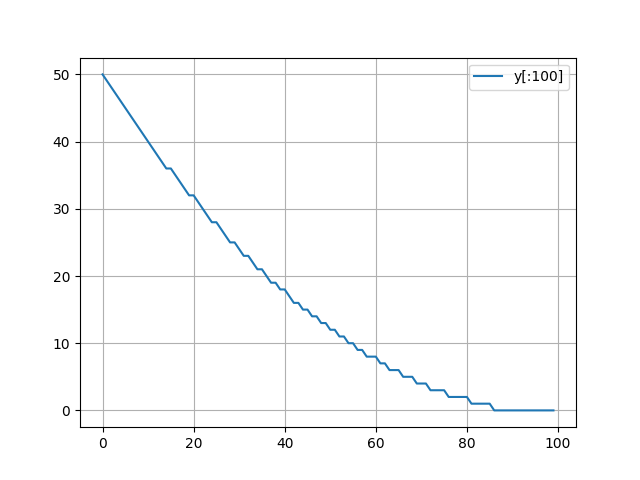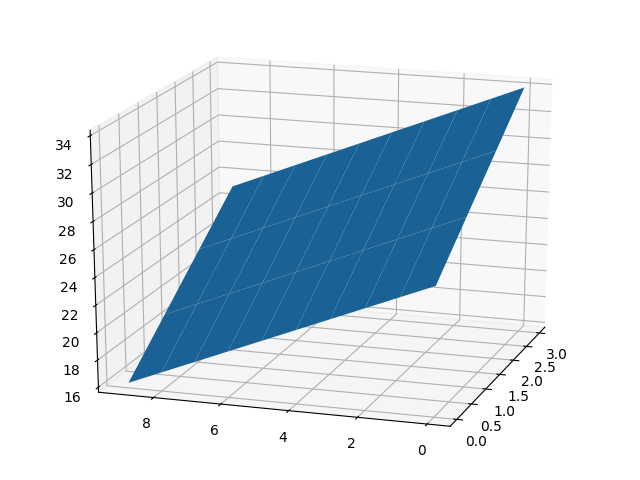GDBplotlib is an extension to GDB which enables easy visualisation and exporting of data structures. The current implementation is focused on C++, although it could theoretically be extended to work with any language supported by GDB. Ken Mankoff has created a fork that adds Fortan support, which can be found here.
- Many different visualisations, such as line graphs, scatter plots and histograms
- Exporting of variables in
.mat, Python pickle and binary formats - Works for arbitrarily nested data structures
- Slice support
- Can be easily extended to work with any custom type
- GDB >= 7.0
- Python 3
- NumPy
- Matplotlib
- Scipy (OPTIONAL - for exporting to
.mat)
GDBplotlib can be installed via pip:
$ pip install gdbplotlibTo make GDBplotlib available in GDB sessions, add the following lines to ~/.gdbinit (or create it if it doesn't exist):
python
import gdbplotlib
endConsider the following C++ program:
#include <vector>
#include <array>
int main()
{
std::array<double, 6> x = {0.1, 0.9, 0.8, 0.7, 0.2, 0.1};
int* y = new int[100];
for (int i = 0; i < 100; ++i) {
y[i] = 50 - i + int(5e-3 * i * i);
}
std::vector<std::array<int*, 10>> z(10);
for (int i = 0; i < z.size(); ++i) {
for (int j = 0; j < z[i].size(); ++j) {
z[i][j] = new int[10];
for (int k = 0; k < 10; ++k) {
z[i][j][k] = i + 2*j + 3*k;
}
}
}
return 0;
}To create a line graph of x, execute the command:
plot x
GDBplotlib has full support for Python-style slicing. For example, to plot only the first 3 elements, simply execute:
plot x[:3]
Pointers are an example of an unbounded type - that is a type for which it is not possible to deduce the number of elements. In order to correctly plot the variable y, the user must explicitily give an endpoint using the slice syntax:
plot y[:100]
Note that when slicing an unbounded type, negative start/end slice indices no longer refer to an index relative to the container's end (as in Python), but rather relative its start (as in C indexing).
GDBplotlib supports data extraction of arbitrarily nested structures. For example, to create a 3D plot of z, run:
plot3d z[::-1,2,4:8]
std::vectorstd::array- C-style array
- Pointer
- All integral and floating point types
std::complex<float>andstd::complex<double>
plot VAR...- Create a 1D line plot ofVAR, whereVARis any 1D or 2D structureplot3d VAR- Create a 2D surface plot ofVAR, whereVARis a 2D real-valued structurescatter VAR...- Create a 2D scatter plot ofVAR, whereVARis either a 1D complex-valued structure, an N-by-2 real-valued structure, or two 1D real-valued structuresscatter3d VAR...- Create a 3D scatter plot ofVAR, whereVARis either an N-by-3 real-valued structure, or three 1D real-valued structureshist VAR...- Create a histogram plot ofVAR, whereVARis any 1D or 2D structurefft VAR...- Create a power spectral density plot ofVAR, whereVARis any 1D structuresave FILE VAR- SaveVARto the fileFILEin binary formatsavepy FILE VAR- SaveVARto the fileFILEin Python pickle formatsavemat FILE VAR...- SaveVARto the fileFILEin Matlab format
It is easy to extend GDBplotlib to handle any desired type. Let's look at an example of how we might implement support for std::vector:
from gdbplotlib.type_handler import TypeHandler
from gdbplotlib.default import default
class StdVector(TypeHandler):
@staticmethod
def can_handle(gdb_type: gdb.Type) -> bool:
return str(gdb_type).startswith("std::vector")
def shape(self, gdb_value: gdb.Value) -> Tuple[Optional[int], ...]:
size = int(gdb_value["_M_impl"]["_M_finish"] - gdb_value["_M_impl"]["_M_start"])
return (size,)
def contained_type(self, gdb_value: gdb.Value) -> gdb.Type:
return gdb_value.type.template_argument(0)
def extract(self, gdb_value: gdb.Value, index: Tuple[int, ...]):
return (gdb_value["_M_impl"]["_M_start"] + index[0]).dereference()
default.register(StdVector)To handle a custom type, we must create a class derived from the abstract base class gdbplotlib.TypeHandler. There are 4 methods that need to be overriden:
can_handle- Given a type, determine whether this handler is able to handle it. For astd::vector, we want to handle any type whose name begins withstd::vectorshape- Given a value of our type, return the shape (in the NumPy sense) of the container as a tuple. The length of the tuple is equal to the number of dimensions of our type, and the values are size of the given dimension. If a given dimension has an unbounded size (as in the case of a pointer), that dimension should be given a value ofNone. Astd::vectoris 1-dimensional, with a size equal to the difference between the start and end pointers.contained_type- Given a value of our type, return the type of any contained elements. This is usually either a fixed type, or one of the type's template arguments. For astd::vector, it is the first template argument.extract- Given an index, extract an element from the container. Theindexparameter is ann-length tuple, wherenis the number of dimensions of the container. For astd::vector, we increment the start pointer by the first (and only) index, and dereference to get the value.
Finally, we register our type handler with GDBplotlib so that it can be used with any command. Note that we register the class itself, not its instantiation.
class Float(ScalarTypeHandler):
@staticmethod
def can_handle(gdb_type: gdb.Type) -> bool:
return str(gdb_type) == "float"
def extract(self, gdb_value: gdb.Value, index: Tuple[int, ...]):
return np.float32(gdb_value)Handling a custom scalar type is a similar process. The main difference is that we derive from gdbplotlib.ScalarTypeHandler. As a result, it is not necessary to override shape and contained_type. Then, in the extract method, we extract the value and return it as a NumPy data type.
The implemntation of a custom type handler relies heavily on the GDB Python API, particularly gdb.Value and gdb.Type. Documentation for the API can be found at the following link.
Special thanks to Brian Hone, whose gdb-plot served as the inspiration for this project.



